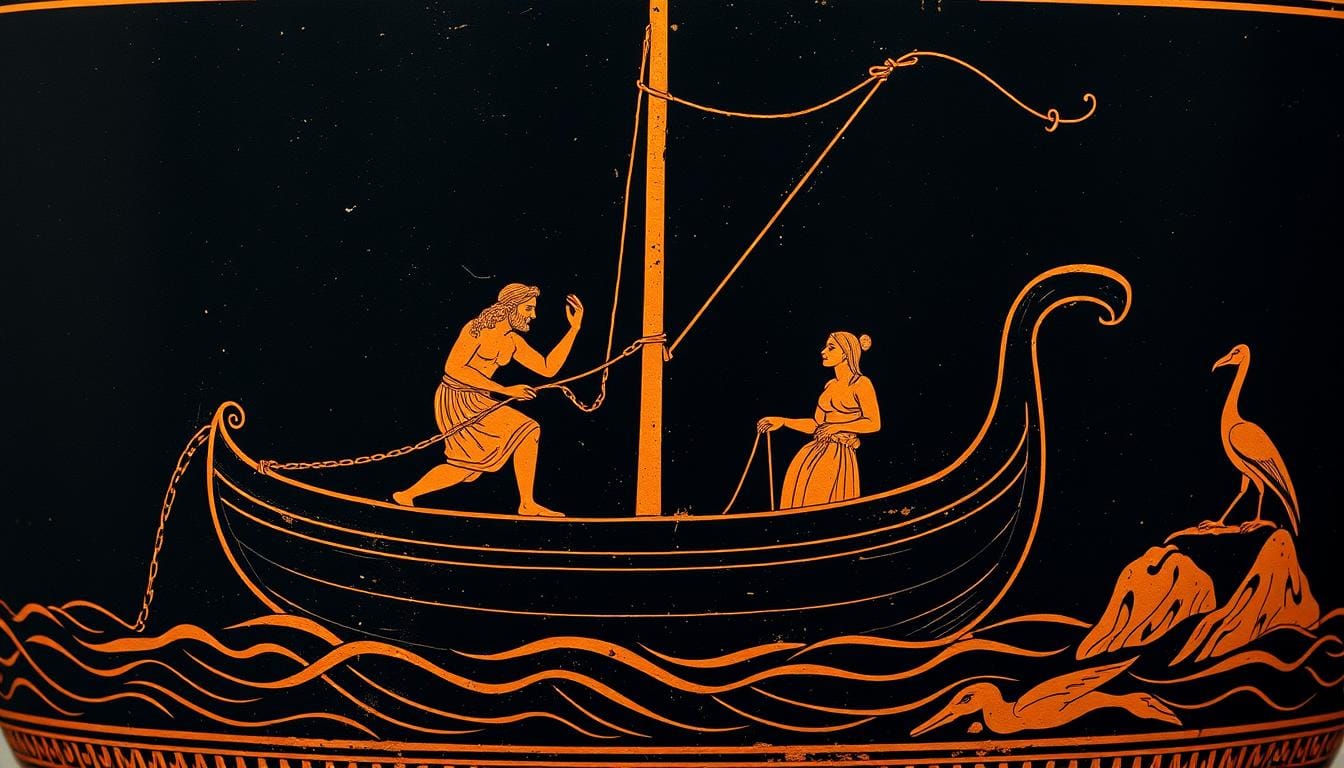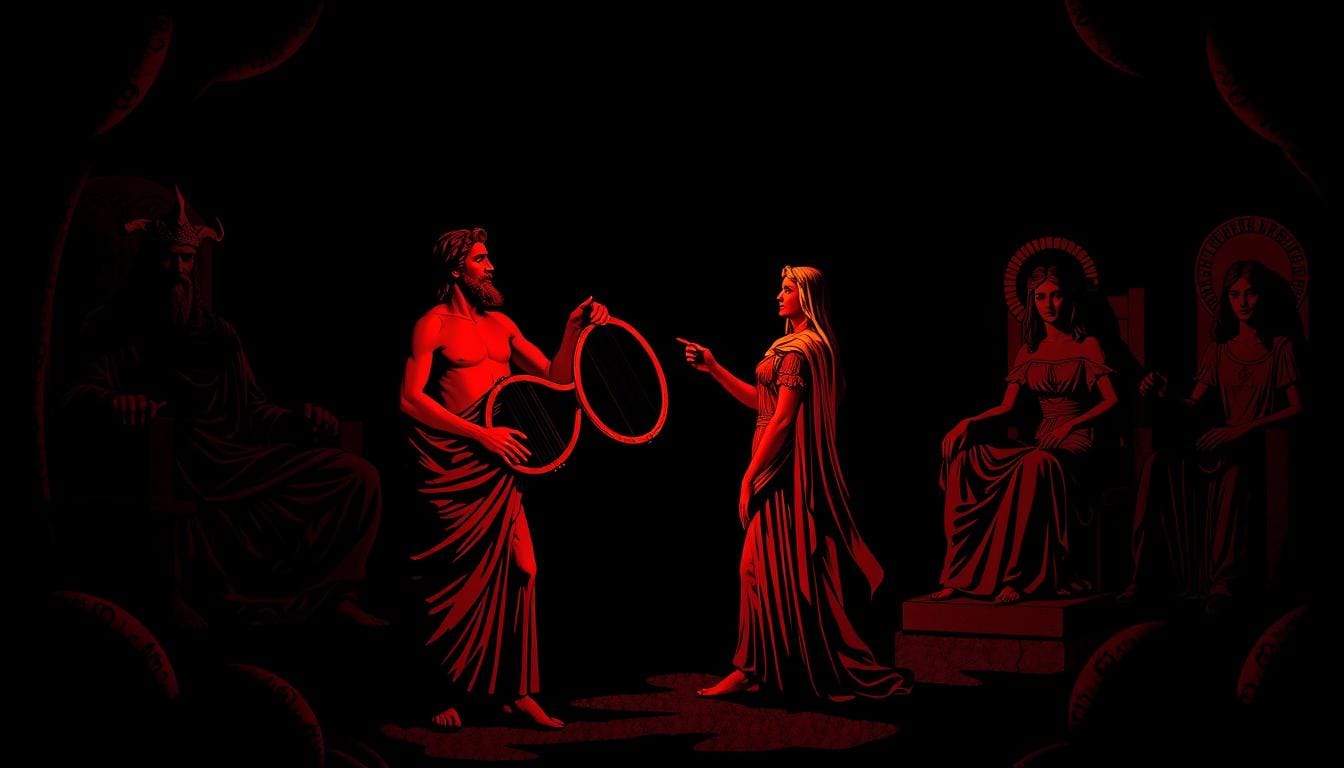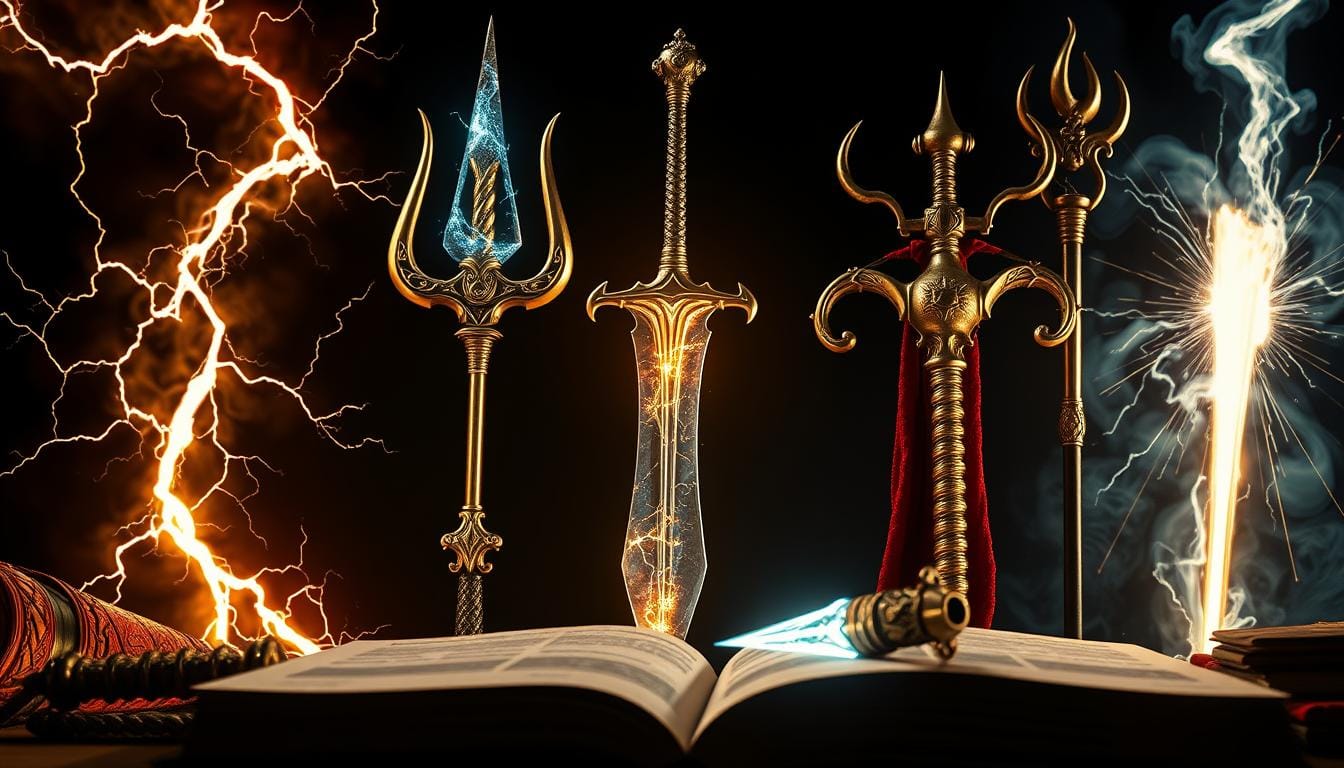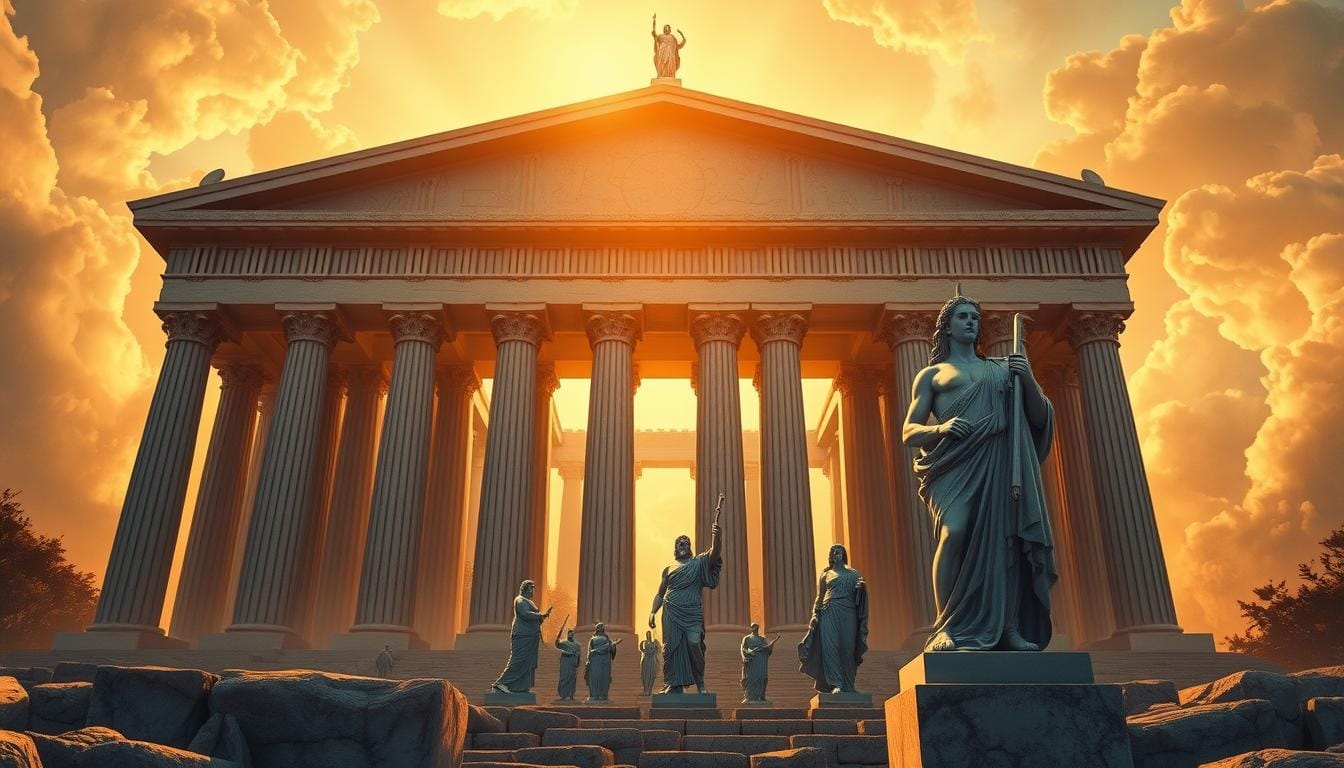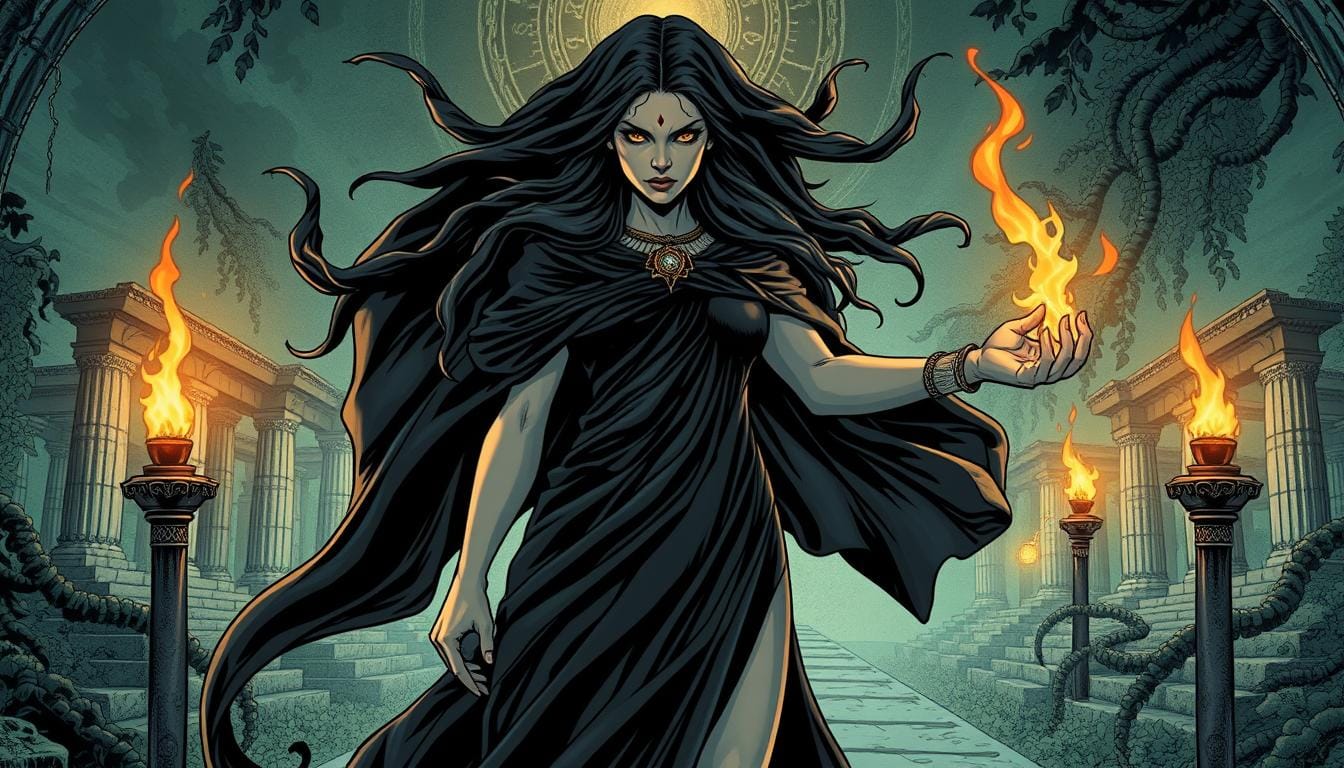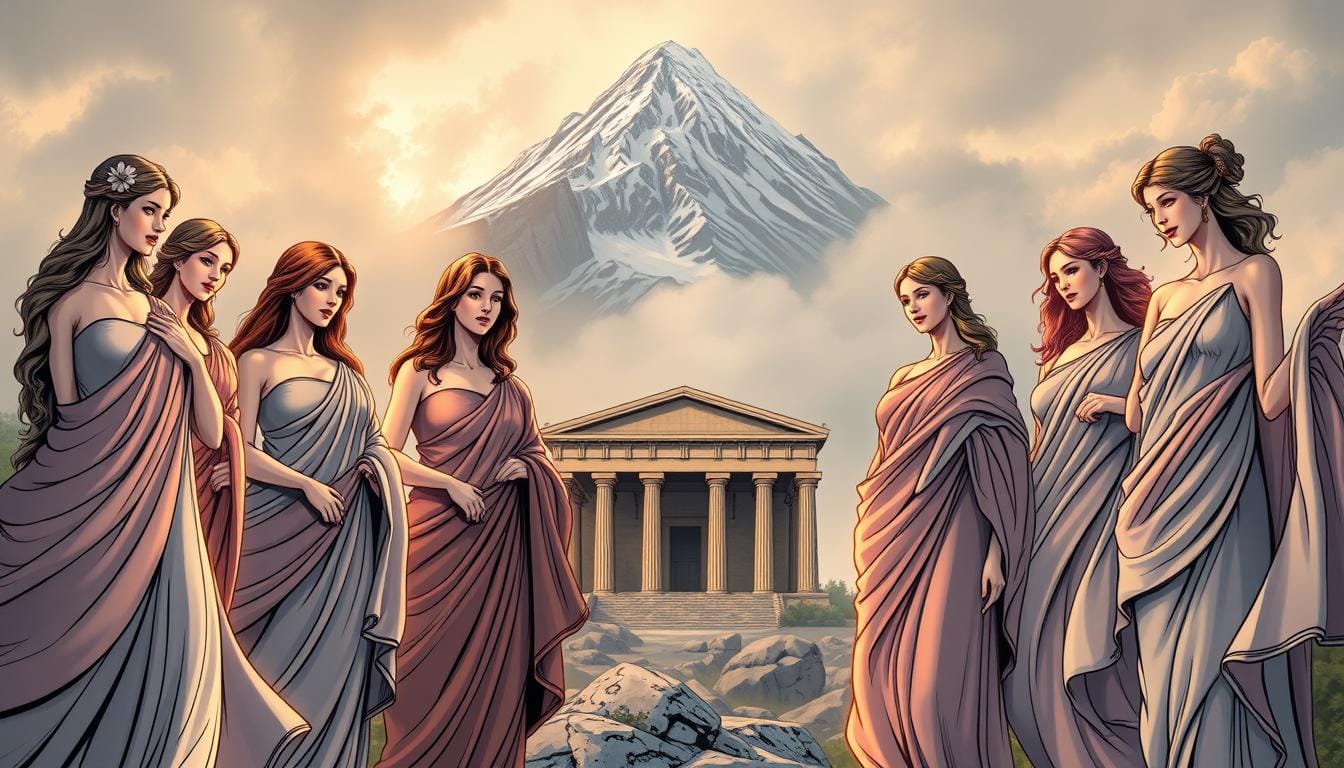Did you know that over 3,000 temples were dedicated to Zeus across the ancient Mediterranean world? This number shows how much this powerful god influenced ancient civilizations for over a thousand years. We’re excited to take you through the amazing world of the most powerful figure in ancient mythology.
Zeus, the supreme ruler of Mount Olympus, controlled thunder and lightning. He also ruled over all other gods. Greek mythology sees him as the ultimate symbol of divine power. His influence is seen in art, literature, and religious practices that inspire travelers in Greece today.
If you’re planning a trip to Greece’s ancient temples or just curious about classical heritage, knowing about Zeus is key. We think learning about these mythological roots makes every traveler’s experience of Greek culture richer.
Key Takeaways
- Zeus ruled as king of the gods from Mount Olympus in ancient Greek religion
- Over 3,000 temples were built across the Mediterranean to honor this sky deity
- His Roman equivalent was Jupiter, showing cross-cultural influence
- Zeus controlled thunder, lightning, and weather as his primary divine powers
- Understanding his mythology enhances visits to Greek archaeological sites
- His stories influenced Western art, literature, and culture for centuries
Mythological Origins and Rise to Power
Before Zeus became the king of gods, his life was a tale of danger and divine help. This story is one of the most exciting in mythology. It shows how Zeus went from a hidden baby to the top ruler of the Greek gods.
The Titans ruled the world with force. They were feared and their future was predicted. This led to a change that would affect everything.
Birth and Escape from Kronos
Zeus was born to Titans Kronos and Rhea. His father was scared of a prophecy. One of his children would overthrow him, just like he did to his father.
Kronos wanted to stop this by eating each new baby. Zeus’s siblings were eaten one by one.
Rhea couldn’t lose another child. She tricked Kronos by giving him a stone instead of Zeus. The Titan king swallowed the rock, thinking he had eaten his threat.
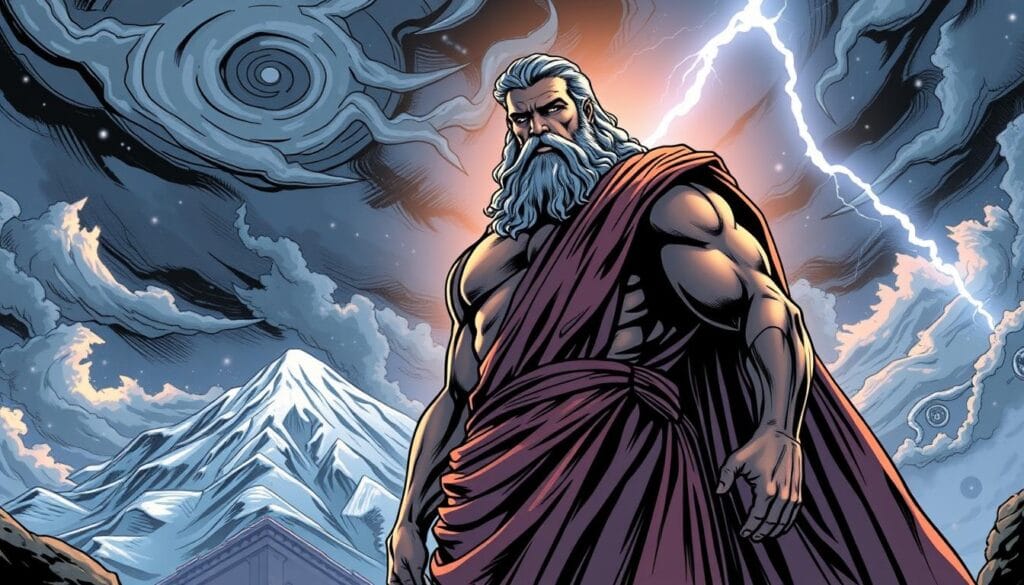
Rhea took Zeus to a cave on Crete. There, he was raised by Amalthea, a divine goat. The Kouretes, warrior-priests, protected him with their loud dances.
The Great Titanomachy War
Zeus grew up in secret, getting stronger and wiser. He knew he had to face his father. He wanted to free his swallowed siblings.
Zeus tricked Kronos into drinking a potion. This made the Titan king vomit up his children. Hestia, Demeter, Hera, Hades, and Poseidon were freed and ready for battle.
The Great Titanomachy war lasted ten years. Zeus had the help of powerful beings. The Cyclopes made his thunderbolts, and giants joined his side.
Division of the Cosmos
Zeus and his allies won the war. The Titans were sent to Tartarus. This victory brought a new order to the gods and mortals.
The three brothers divided the world. Zeus got the heavens, Poseidon the seas, and Hades the underworld. This division was the start of Greek mythology.
Zeus’s journey from hidden baby to king shows that even the strongest can fall. Courage, cunning, and destiny can change everything.
Zeus: Divine Powers and Celestial Domains
Ancient Greeks saw Zeus as the top god, ruling over all. His powers were so great that people both feared and respected him. He influenced everything, from the weather to moral rules.
The thunder god had powers beyond just showing strength. He kept the universe in balance, guiding both gods and humans. This made Zeus the key figure in Greek myths and religion.
Thunder God and Sky Ruler
Zeus was known as the god of the sky for his control over weather. He could call thunder, lightning, rain, and wind at will. His lightning bolt was a symbol of his power.
When storms hit, people knew Zeus was showing his power. Farmers prayed for gentle rains for their crops. Sailors hoped for calm seas. The Greeks called him “cloud-gatherer,” showing his weather control.
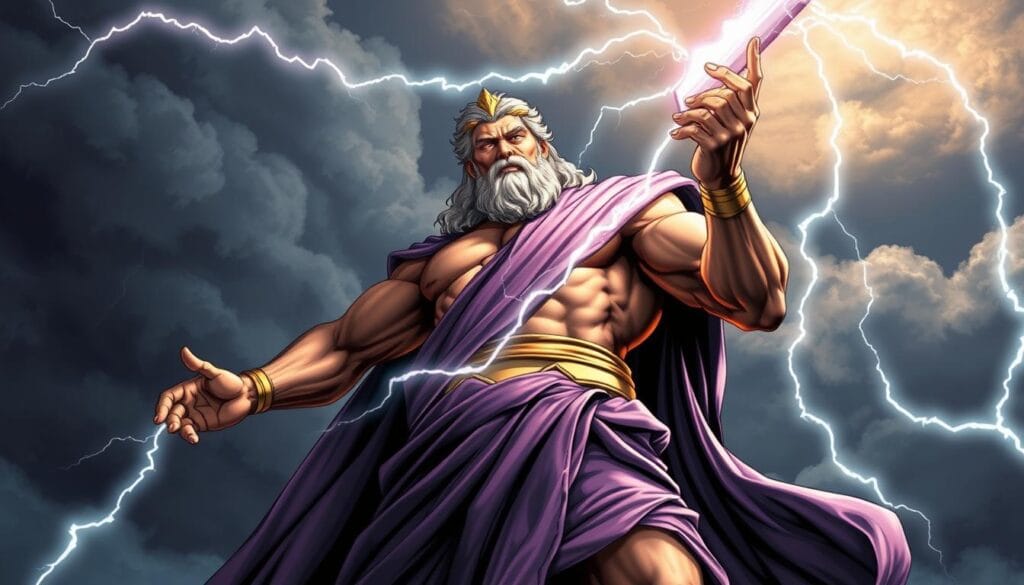
Zeus’s power wasn’t just about storms. He brought rains that helped crops grow. This made him a complex god, both loved and feared.
King of Mount Olympus
From Mount Olympus, Zeus ruled the gods with no one questioning him. His leadership style was like that of earthly kings, who claimed power from gods. His court was the model for human governments.
The divine hierarchy under Zeus kept the gods in order. He settled disputes and assigned roles. This kept both divine and human worlds in balance.
Zeus’s palace on Olympus was the heart of divine rule. Decisions for humans were made there. This celestial court shaped Greek views on leadership.
Divine Justice and Cosmic Order
Zeus’s role as judge shaped Greek views on morality and justice. He rewarded the good and punished the bad. Ancient Greeks believed he watched over humans, ensuring justice.
The protection of sacred oaths was Zeus’s special duty. Breaking promises or violating hospitality laws would anger him. He protected the bonds that held society together.
Zeus also protected the weak and powerless. Those seeking mercy could appeal to him. He was both strict and kind, caring for all his subjects.
Sacred Symbols and Divine Attributes
The symbols of Zeus were instantly recognizable in ancient art. They crossed cultural lines, creating a universal language we see today in museums. Each symbol had deep meanings, showing different sides of Zeus’s power.
Ancient artists used symbols to show Zeus’s power. These symbols were on coins, pottery, and temple walls. They helped spread Zeus’s influence far and wide.
The Lightning Bolt and Golden Eagle
The zeus lightning bolt is a symbol of divine power. It meant more than just force; it showed Zeus’s power to keep balance and justice. Artists always drew it with zigzag patterns, making it easy to spot.
The golden eagle was Zeus’s messenger and sign of heaven’s rule. It could fly high, showing Zeus’s sky connection. Legend says Zeus turned into an eagle to take Ganymede to Mount Olympus, linking the eagle to divine power.
Art often showed Zeus with an eagle and lightning bolt. This made a strong statement about his role as both protector and punisher.
Oak Groves and Sacred Animals
Oak groves were key in Zeus worship, like at Dodona’s oracle. Priests believed oak leaves carried Zeus’s messages. These trees were like living temples for guidance.
Bulls were sacred to Zeus, showing strength and fertility. Myths, like Zeus becoming a white bull to take Europa, highlight their power.
Serpents and rams were also sacred. Serpents meant wisdom and rebirth, while rams showed leadership and determination. These qualities were key for Zeus.
Royal Regalia and Divine Weapons
Zeus’s scepter was a symbol of his divine rule. It was often decorated with an eagle or lightning bolt. This staff showed his power over gods and mortals.
The aegis was Zeus’s shield or armor. It had Medusa’s head and made him almost invincible in battle. It could also cause thunderstorms and scare enemies.
Zeus’s throne was his seat of power and judgment. Zeus statue often showed him sitting on this throne. The famous zeus statue at Olympia was one of the Seven Wonders of the Ancient World.
| Symbol | Meaning | Artistic Representation | Cultural Significance |
|---|---|---|---|
| Lightning Bolt | Divine Justice & Power | Zigzag weapon in hand | Universal symbol of authority |
| Golden Eagle | Heavenly Messenger | Perched beside throne | Connection to sky realm |
| Oak Tree | Oracular Wisdom | Sacred grove settings | Divine communication |
| Royal Scepter | Supreme Authority | Golden staff with eagle | Symbol of kingship |
These symbols gave ancient people a way to understand and worship Zeus. Today, we can see them in museums and connect with our ancestors’ beliefs.
Family Connections and Legendary Offspring
Zeus was more than just a god of thunder. He had a vast family network that shaped Mount Olympus. His personal life led to complex family stories that are part of Greek mythology. These tales are loved by travelers to Greece today.
Zeus’s family tree is filled with divine politics and love affairs. His children became both revered gods and legendary heroes of ancient Greece. This shows why Zeus was so important in Greek culture.
Marriage to Hera and Olympian Children
Zeus married his sister Hera, creating a powerful divine couple in ancient Greece. Their marriage was filled with jealousy and conflict. Yet, they had several important children together.
Ares, the god of war, got his strength and fierce nature from his parents. Hebe, the goddess of youth, served nectar to the gods. Eileithyia, the goddess of childbirth, helped bring new life.
Zeus and Hera’s marriage was like many human ones. Their struggles with trust and fidelity were relatable to mortals in ancient Greece.
Mortal Affairs and Heroic Descendants
Zeus’s love affairs with mortals created legendary heroes. He was creative in his approaches, like turning into a swan or a bull.
These unions led to incredible offspring. Perseus defeated Medusa with divine help. Heracles completed twelve impossible labors. Helen of Troy sparked the famous Trojan War.
Each of Zeus’s descendants carried a piece of his divine nature. Their stories are told in Greek archaeological sites today, inspiring visitors.
Complex Relationships with Divine Siblings
Zeus’s relationships with his siblings shaped Mount Olympus. After defeating Kronos, the brothers divided the cosmos. Zeus got the sky, while his brothers ruled the seas and underworld.
His affairs with goddesses produced important deities. Apollo and Artemis came from Leto. Hermes was born from Maia. Athena was born from Zeus’s head after he swallowed Metis.
These family dynamics led to alliances and rivalries in Greek mythology. They influenced everything from seasonal changes to mortal conflicts in ancient Greece.
Famous Myths and Cultural Worship
Zeus was a hero in ancient Greek stories for centuries. His tales shaped daily life and spiritual practices. These stories taught moral lessons and explained natural wonders.
Zeus’s worship united Greek communities. His influence reached every part of ancient society. People honored him with devotion for over a thousand years.
Epic Stories and Divine Interventions
The myth of Prometheus stealing fire shows Zeus’s complex side. He had to decide between helping mortals and punishing Prometheus. This dilemma led to the creation of Pandora.
Pandora was the first woman, made as punishment. Zeus knew she would open a box, releasing troubles. This story teaches moral lessons in Greek myths.
The great flood myth shows Zeus’s role as cosmic judge. He cleansed the world of wickedness, sparing Deucalion and Pyrrha. This story is similar to many others worldwide, showing universal themes of justice.
Zeus’s battles against the Giants, known as the Gigantomachy, symbolize order vs. chaos. These battles were not just physical but also symbolic. Zeus’s victory over Typhon solidified his role as defender of order.
Ancient Temples and Religious Practices
The Temple of Zeus at Olympia was one of the Seven Wonders. Its gold and ivory statue amazed visitors. People traveled far to see this divine masterpiece.
The oracle at Dodona offered spiritual guidance. Priests interpreted Zeus’s will through sacred oak leaves. This practice helped rulers and people for over a thousand years.
Zeus worship varied across the Greek world. Communities built shrines and temples that reflected their traditions. This diversity united people under Zeus’s divine authority.
| Sacred Site | Location | Primary Function | Notable Features |
|---|---|---|---|
| Temple of Zeus | Olympia | Olympic Games venue | Statue by Phidias, Wonder of Ancient World |
| Oracle of Dodona | Epirus | Prophetic consultation | Sacred oak trees, bronze vessels |
| Temple of Zeus | Athens | City worship center | Largest temple in Greece, 700-year construction |
| Mount Lykaion | Arcadia | Mountain sanctuary | Ancient altar, athletic competitions |
Zeus was honored with festivals throughout the year. The Olympic Games started in his honor. These events combined sports with spiritual devotion, shaping modern sports.
Artistic Representations and Personality Traits
Artists depicted Zeus with regal dignity and passionate intensity. He was seen as a leader and a cautionary example. Sculptures showed his strength and authority. Painters captured his range of emotions.
Zeus was wise but also impulsive. He was generous and protective to those who honored him. But he showed jealousy and anger when challenged or betrayed.
Writers described him as having a quick temper but also compassion for justice. His struggles with family and moral decisions reflected human challenges. This made him more complex than a simple deity.
Today, Zeus’s legacy is explored in literature, film, and art. His influence is seen in discussions about power, responsibility, and human nature. We see his impact in modern leadership and authority.
Conclusion
Zeus’s influence spread far in ancient Greek religion and culture. His worship changed with local traditions but kept his status as king of gods. Today, you can see his legacy in Greece’s archaeological sites and cultural landmarks.
When you visit Greece, Zeus’s presence is everywhere. Olympia’s ruins tell tales of ancient games held in his honor. Dodona’s sacred groves remember pilgrims seeking divine guidance. Museums show many artifacts celebrating his rule over Mount Olympus.
Zeus’s character is complex – both a just ruler and an unpredictable force. This mirrors our own relationship with power and nature. Travelers seeking real connections to Greece’s heritage find these themes compelling. Every temple column and marble sculpture shares part of his story.
For those planning Greek adventures, knowing Zeus helps appreciate the country’s cultural treasures. His myths shaped Western civilization and inspire art, literature, and popular culture globally.
Ready to explore Zeus’s world? Check out our podcast episode on Greek mythology and travel tips. Let his legendary journey inspire your own Greek adventure, where ancient stories meet modern discovery.
